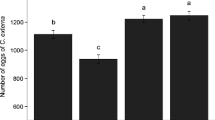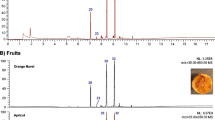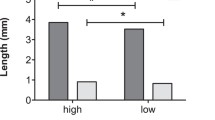Abstract
Low concentrations of dietary triacylglycerols including tristearin, triolein, and tripalmitolein, were assessed to determine their effects during egg to pupal stages on adult epicuticular hydrocarbon (EHC) variation in cactophilic Drosophila mojavensis. Triacylglycerols were added singly and in combination at concentrations of 1%, 3%, and 9% to a lipid-free culture medium. Control diets included Carolina Drosophila and lipid-free media. Egg to adult viability was reduced at triacylglycerol concentrations greater than 1%, except for tristearin. Both triolein and tripalmitolein increased EHC amounts to levels similar to those in combination and control diets. Tristearin caused significantly lower quantities of EHCs in adult flies than triolein or tripalmitolein, consistent with previous studies on reduced tristearin assimilation into adult EHCs. We rejected the hypothesis that unsaturated and saturated triacylglycerols were assimilated into unsaturated and saturated adult EHCs, respectively. Since these triacylglycerols comprise a fraction of known lipids in the columnar cacti used for breeding in nature, and EHCs serve as contact pheromones in D. mojavensis, these and other naturally occurring triacylglycerols may provide a direct causal link between host plant use and patterns of chemically mediated mate choice.


Similar content being viewed by others
References
Becerra, J. X. 1997. Insects on plants: Macroevolutionary chemical trends in host use. Science 276:253–256.
Bernays, E. A. and Chapman, R. F. 1994. Host-Plant Selection by Phytophagous Insects. Chapman and Hall, London.
Blomquist, G. J. 2003. Biosynthesis and ecdysteroid regulation of housefly sex pheromone production, pp. 231–252, in G. J. Blomquist and R. C. Vogt (eds.). Insect Pheromone Biochemistry and Molecular Biology. Elsevier, San Diego.
Blomquist, G. J., Dillworth, J. W., and Adams, T. S. 1987. Biosynthesis and endocrine regulation of sex pheromone production in Diptera, pp. 217–250, in G. D. Prestwitch and G. J. Blomquist (eds.). Pheromone Biochemistry. Academic Press, London.
Boake, C. R. B., Deangelis, M. P., and Andreadis, D. K. 1997. Is sexual selection and species recognition a continuum? Mating behavior of the stalk-eyed fly Drosophila heteroneura. Proc. Natl. Acad. Sci. USA 94:12442–12445.
Brazner, J. C. and Etges, W. J. 1993. Pre-mating isolation is determined by larval rearing substrates in cactophilic Drosophila mojavensis. II. Effects of larval substrates on time to copulation, mate choice, and mating propensity. Evol. Ecol. 7:605–624.
Buczkowski, G., Kumar, R., Suib, S. L., and Silverman, J. 2005. Diet-related modification of cuticular hydrocarbon profiles of the Argentine ant, Linepithema humile, diminishes intercolony aggression. J. Chem. Ecol. 31:829–843.
Carson, H. L. 2000. Sexual selection in populations: the facts require a change in the genetic definition of the species, pp. 495–512, in R. S. Singh and C. Krimbas (eds.). Evolutionary Genetics: From Molecules to Morphology. Cambridge University Press, New York.
Chan Yong, T. P. and Jallon, J. M. 1986. Synthese de novo d’hydrocarbures potentiellement aphrodisiaques chez les Drosophiles. C. R. Acad. Sci. Paris 303:197–202.
Dallerac, R., Labeur, C., and Wicker-Thomas, C. 2000. A Delta-9 desaturase gene with a different substrate specificity is responsible for cuticular diene hydrocarbon polymorphism in Drosophila melanogaster. Proc. Natl. Acad. Sci. USA 97:9449–9454.
De Renobales, M. and Blomquist, G. J. 1984. Biosynthesis of medium chain fatty acids in Drosophila melanogaster. Arch. Biochem. Biophy. 228:407–414.
Etges, W. J. 1989. Evolution of developmental homeostasis in Drosophila mojavensis. Evol. Ecol. 3:189–201.
Etges, W. J. 1992. Premating isolation is determined by larval rearing substrates in cactophilic Drosophila mojavensis. Evolution 46:1945–1950.
Etges, W. J. 1998. Premating isolation is determined by larval rearing substrates in cactophilic Drosophila mojavensis. IV. Correlated responses in behavioral isolation to artificial selection on a life history trait. Am. Nat. 152:129–144.
Etges, W. J. 2002. Divergence in mate choice systems: Does evolution play by rules? Genetica 116:151–166.
Etges, W. J. and Ahrens, M. A. 2001. Premating isolation is determined by larval rearing substrates in cactophilic Drosophila mojavensis. V. Deep geographic variation in epicuticular hydrocarbons among isolated populations. Am. Nat. 158:585–598.
Etges, W. J. and Heed, W. B. 1987. Sensitivity to larval density in populations of Drosophila mojavensis: Influences of host plant variation on components of fitness. Oecologia 71:375–381.
Etges, W. J. and Jackson, L. L. 2001. Premating isolation is determined by larval rearing substrates in cactophilic Drosophila mojavensis. VI. Epicuticular hydrocarbon variation in Drosophila mojavensis cluster species. J. Chem. Ecol. 27:2125–2149.
Etges, W. J., Johnson, W. R., Duncan, G. A., Huckins, G., and Heed, W. B. 1999. Ecological genetics of cactophilic Drosophila, pp. 164–214, in R. Robichaux (ed.). Ecology of Sonoran Desert Plants and Plant Communities. University of Arizona Press, Tucson.
Ferveur, J. F., Cobb, M., and Jallon, J. M. 1989. Complex chemical messages in Drosophila, pp. 397–409, in N. Singh and N. Strausfeld (eds.). Neurobiology of Sensory Systems. Plenum Press, New York.
Fogleman, J. C. and Abril, J. R. 1990. Ecological and evolutionary importance of host plant chemistry, pp. 121–141, in J. S. F. Barker, W. T. Starmer, and R. J. MacIntyre (eds.). Ecological and Evolutionary Genetics of Drosophila. Plenum, New York.
Fogleman, J. C. and Danielson, P. B. 2001. Chemical interactions in the cactus–microorganism–Drosophila model system of the Sonoran Desert. Am. Zool. 41:877–889.
Fogleman, J. C. and Kircher, H. W. 1986. Differential effects of fatty acid chain length on the viability of two species of cactophilic Drosophila. Comp. Biochem. Physiol. 83A:761–764.
Fogleman, J. C., Duperret, S. M., and Kircher, H. W. 1986. The role of phytosterols in host plant utilization by cactophilic Drosophila. Lipids 21:92–96.
Funk, D. J. 1998. Isolating a role for natural selection in speciation: Host adaptation and sexual isolation in Neochlamisus bebbianae leaf beetles. Evolution 52:1744–1759.
Funk, D. J., Filchak, K. E., and Feder, J. L. 2002. Herbivorous insects: Model systems for the comparative study of speciation ecology. Genetica 116:251–267.
Gerhardt, H. C. and Huber, F. 2002. Acoustic Communication in Insects and Anurans. Univ. Chicago Press, Chicago.
Gibbs, A. G., Louie, A. K., and Ayala, J. A. 1998. Effects of temperature on cuticular lipids and water balance in a desert Drosophila: Is thermal acclimation beneficial? J. Exp. Biol. 201:71–80.
Gleason, J. M., Jallon, J.-M., Rouault, J.-D., and Ritchie, M. G. 2005. Quantitative trait loci for cuticular hydrocarbons associated with sexual isolation between Drosophila simulans and D. sechellia. Genetics 171:1789–1798.
Greenfield, M. D. 2002. Signalers and Receivers: Mechanisms and Evolution of Arthropod Communication. Oxford Univ. Press, New York.
Harborne, J. B. 1982. Introduction to Ecological Biochemistry. Academic Press, New York.
Heed, W. B. 1982. The origin of Drosophila in the Sonoran Desert, pp. 65–80, in J. S. F. Barker and W. T. Starmer (eds.). Ecological Genetics and Evolution: The Cactus–Yeast–Drosophila Model System. Academic Press, Sydney.
Heed, W. B. and Mangan, R. L. 1986. Community ecology of the Sonoran Desert Drosophila, pp. 311–345, in M. Ashburner, H. L. Carson, and J. N. Thompson (eds.). The Genetics and Biology of Drosophila. Academic Press, New York.
Howard, R. W. 1998. Ontogenetic, reproductive, and nutritional effects on the cuticular hydrocarbons of the host-specific ectoparasitoid Cephalonomia tarsalis (Hymenoptera: Bethylidae). Ann. Entomol. Soc. Am. 91:101–112.
Howard, R. W., Howard, C. D., and Colquhoun, S. 1995. Ontogenetic and environmentally induced changes in cuticular hydrocarbons of Oryzaephilus surinamensis (Coleoptera: Cucujidae). Ann. Entomol. Soc. Am. 88:485–495.
Jallon, J.-M. 1984. A few chemical words exchanged during courtship and mating of Drosophila melanogaster. Behav. Gen. 14:441–478.
Jallon, J.-M., Antony, C., Chang Yong, T. P., and Maniar, S. 1986. Genetic factors controlling the production of aphrodisiac substance in Drosophila, pp. 445–452, in M. Porchet, J. C. Andries, and A. Dhainaut (eds.). Advances in Invertebrate Reproduction. Elsevier, Amsterdam.
Jallon, J.-M. and Wicker-Thomas, C. 2003. Genetic studies on pheromone production in Drosophila, pp. 253–281, in G. J. Blomquist and R. C. Vogt (eds.). Insect Pheromone Biochemistry and Molecular Biology. Elsevier, San Diego.
Keith, A. D. 1967a. Fatty acid metabolism in D. melanogaster: Formation of palmitoleate. Life Sci. 6:213–218.
Keith, A. D. 1967b. Fatty acid metabolism in Drosophila melanogaster: Interaction between dietary fatty acids and de novo synthesis. Comp. Biochem. Physiol. 21:587–600.
Labeur, C., Dallerac, R., and Wicker-Thomas, C. 2002. Involvement of Desat1 gene in the control of Drosophila melanogaster pheromone biosynthesis. Genetica 114:269–274.
Liang, D. and Silverman, J. 2000. “You are what you eat”: Diet modifies cuticular hydrocarbons and nestmate recognition in the Argentine ant, Linepithema humile. Naturwissenschaften 87:412–416.
Markow, T. A. 1982. Mating systems of cactophilic Drosophila, pp. 273–287, in J.\ S. F. Barker and W. T. Starmer (eds.). Ecological Genetics and Evolution: The Cactus–Yeast–Drosophila Model System. Academic Press, Sydney.
Nosil, P., Crespi, B. J., and Sandoval, C. P. 2002. Host-plant adaptation drives the parallel evolution of reproductive isolation. Nature 417:441–443.
Pennanec’h, M., Bricard, L., Kunesch, G., and Jallon, J.-M. 1997. Incorporation of fatty acids into cuticular hydrocarbons of male and female Drosophila melanogaster. J. Insect Physiol. 43:1111–1116.
Pennanec’h, M., Ferveur, J. F., Pho, D. B., and Jallon, J.-M. 1991. Insect fatty acid related pheromones: A review of their biosynthesis, hormonal regulation and genetic control. Ann. Soc. Entomol. Fr. 27:245–263.
Sandoval, C. P. and Nosil, P. 2005. Counteracting selective regimes and host preference evolution in ecotypes of two species of walking-sticks. Evolution 59:2405–2413.
SAS Institute, I. 2004. SAS/STAT 9.1.2. SAS Institute, Cary, NC.
Savarit, F. and Ferveur, J.-F. 2002. Temperature affects the ontogeny of sexually dimorphic cuticular hydrocarbons in Drosophila melanogaster. J. Exp. Biol. 205:3241–3249.
Savarit, F., Sureau, G., Cobb, M., and Ferveur, J.-F. 1999. Genetic elimination of known pheromones reveals the fundamental chemical bases of mating and isolation in Drosophila. Proc. Nat. Acad. Sci. USA 96:9015–9020.
Scheiner, S. M. 1993. Manova: Multiple response variables and multispecies interactions, pp. 94–112, in S. M. Scheiner and J. Gurevitch (eds.). Design and Analysis of Ecological Experiments. Chapman and Hall, New York.
Stennett, M. D. and Etges, W. J. 1997. Pre-mating isolation is determined by larval rearing substrates in cactophilic Drosophila mojavensis. III. Epicuticular hydrocarbon variation is determined by use of different host plants in Drosophila mojavensis and Drosophila arizonae. J. Chem. Ecol. 23:2803–2824.
Thompson, J. N. 1994. The Coevolutionary Process. University of Chicago Press, Chicago.
Toolson, E. C. and Kuper-Simbron, R. 1989. Laboratory evolution of epicuticular hydrocarbon composition and cuticular permeability in Drosophila pseudoobscura: Effects of sexual dimorphism and thermal-acclimation ability. Evolution 43:468–472.
Toolson, E. C., Markow, T. A., Jackson, L. L., and Howard, R. W. 1990. Epicuticular hydrocarbon composition of wild and laboratory-reared Drosophila mojavensis Patterson and Crow (Diptera: Drosophilidae). Ann. Entomol. Soc. Am. 83:1165–1176.
Wicker-Thomas, C., Henriet, C., and Dallerac, R. 1997. Partial characterization of a fatty acid desaturase gene in Drosophila melanogaster. Insect Biochem. Mol. Biol. 27:963–972.
Wicker-Thomas, C. and Jallon, J.-M. 2001. Control of female pheromones in Drosophila melanogaster by homeotic genes. Genet. Res. (Camb) 78:235–242.
Wigglesworth, V. B. 1988. The source of lipids and polyphenols for the insect cuticle: The role of fat body, oenocytes and oenocytoids. Tissue Cell 20:919–932.
Woodrow, R. J., Grace, J. K., Nelson, L. J., and Haverty, M. I. 2000. Modification of cuticular hydrocarbons of Cryptotermes brevis (Isoptera: Kalotermitidae) in response to temperature and relative humidity. Environ. Entomol. 29:1100–1107.
Acknowledgments
We thank J. C. Fogleman for information about host cactus chemistry, B. Durham for access to the GC, and S.J. Seybold and two anonymous reviewers for constructive comments. This work was partially supported by an REU supplement to NSF INT-9724790 (to W. J. Etges and W. B. Heed), NSF DEB-0211125 (to W.J.E.), a SILO Undergraduate Research Fellowship (SURF) grant from the Arkansas Science Information Liaison Office, and the Sturgis Fellowship program at the University of Arkansas.
Author information
Authors and Affiliations
Corresponding author
Electronic supplementary material
Below is the link to the electronic supplemetary material.
Rights and permissions
About this article
Cite this article
Etges, W.J., Veenstra, C.L. & Jackson, L.L. Premating Isolation is Determined by Larval Rearing Substrates in Cactophilic Drosophila mojavensis. VII. Effects of Larval Dietary Fatty Acids on Adult Epicuticular Hydrocarbons. J Chem Ecol 32, 2629–2646 (2006). https://doi.org/10.1007/s10886-006-9187-8
Published:
Issue Date:
DOI: https://doi.org/10.1007/s10886-006-9187-8




